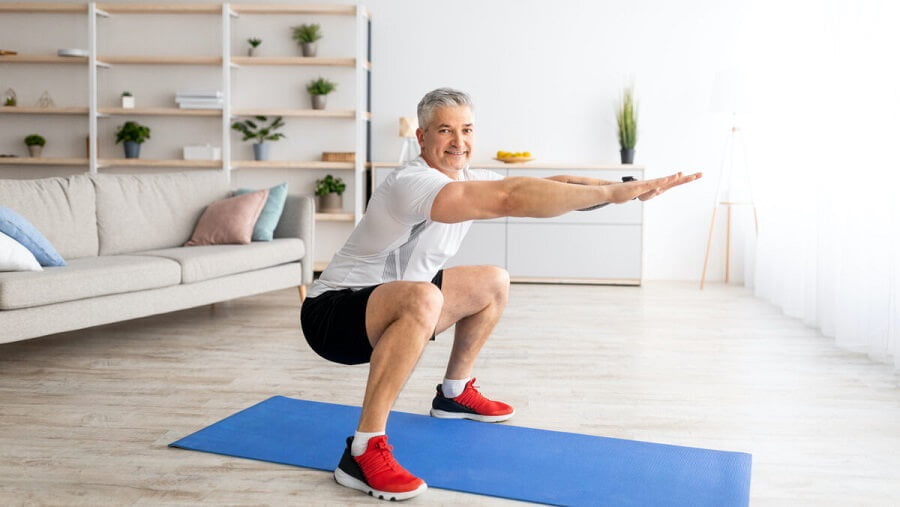
800,000 Americans Undergo Knee Replacement Surgeries Every Year; These Exercises Can Speed Up The Recovery
If you suspect or have been told you need knee replacement surgery, you’re in good company. Hundreds of thousands of Americans receive knee replacements every year because of osteoarthritis and other knee diseases or injuries.
By Mercura Wang & Health 1+1 | The Epoch Times
The knee is the largest joint in our body, and years of wear and tear or injuries can cause severe damage to our knee joint to the point that our knee loses its functionality and using it brings pain and even harm to our health. One of the possible ways to remedy the situation is to undergo a knee replacement surgery.
According to the American Academy of Orthopedic Surgeons (AAOS), every year, around 800,000 people in the United States undergo such a surgery to replace their injured or worn out knee joints. And currently, over 90% of modern knee replacements are still functioning properly 15 years after the surgery.
After the surgery, there is a rehabilitation process that spans several months, with the specific timing depending on the patients’ condition. In his article, we will go over exercises one can do to benefit and speed up the rehab process.
What Is Knee Replacement Surgery?
A knee replacement surgery is also known as total knee replacement and (total) knee arthroplasty. This surgery involves replacing a damaged, worn, or diseased knee joint with an artificial joint, a prosthesis.
Our knees can be severely damaged by arthritis or injury. Once this happens, we may feel pain in our knees while running or walking, or even when we are sitting down or resting. In some cases, knee deformity may take place as a result of an injured knee.
Who Usually Undergoes Knee Arthroplasty?
People of all ages can have knee replacement surgery. Orthopedic surgeons recommend this procedure based on a patient’s physical conditions such as pain and knee function loss, instead of age or other factors.
A potential candidate for knee arthroplasty would be someone who suffers from severe knee pain, chronic knee inflammation, swelling that cannot be cured by medication or rest, knee deformity, as well as limited daily physical activities. Knee replacement operations are used as the last resort, if all other medical treatment methods (e.g. lubricating injections and physical therapy) don’t seem to work.

Specific Steps Involved in a Knee Replacement
When performing a knee arthroplasty, it’s not the entire joint that is being replaced, as only the surface of the bones (i.e. femur, patella, and tibia) in the joint are replaced. Therefore, it is actually a knee “resurfacing” procedure.

Step 1: Removing the damaged cartilage surfaces at the end of the femur and tibia, as well as a small amount of bone.
Step 2: Replacing the removed cartilage and bones with metal implants (i.e. prosthetic devices), which can be cemented into the bones. The metal implants are a femoral component and a tibial component. The femoral component is typically attached to the femur, and the tibial component is inserted into the tibia.
Step 3: Depending on individual cases, possibly resurfacing the patella with a plastic button.
Step 4: Inserting a medical-grade plastic spacer between the components of the metal implants. The spacer is snapped into a tray on the tibial component, and the femoral component slides onto it. This spacer ensures that the metal components glide smoothly when the patient moves.
According to a study published in the journal Arthritis Care & Research, the majority of the patients experience significant improvement in physical activity one year after the surgery, but most of them cannot reach the same activity level as people who’ve never experienced knee problems. Their activity level after surgery is influenced by their previous physical activity behaviours rather than by the surgery. Therefore, despite the knee replacement surgery’s technical advancement and positive outcomes, there’s still limitation to the physical activities a patient can perform after the surgery.
Since being performed for the first time in 1968, knee replacement operations are now considered a safe and effective procedure. However, certain risks associated with it still exist, including infection, blood clots, pain, neurovascular injury, stiff new knee, allergy to the prosthesis, and legs of different lengths. Around 2% of patients experience severe complications.
Effective Rehabilitation Exercises at Different Stages Can Speed Up Recovery
The recovery from a knee replacement surgery usually involves a period of physical therapy. And the duration of the post-surgical recovery period depends on individual patients’ conditions. A full recovery usually takes several months. However, typically, after 12 weeks of rehabilitation, patients can perform most of the physical activities they enjoyed previously when they had healthy knees.
Typically, orthopedic surgeons and physical therapists recommend their patients exercise for 20 to 30 minutes daily, and walk for 30 minutes two to three times per day in the early stages of post-surgical recovery. Depending on the stage of recovery, patients can choose certain exercises to help with their rehabilitation, while avoiding high-impact activities such as running and skiing until they gain a full recovery. Patients should strictly follow the physical therapy regimen designed by their doctors or physical therapists.
Therefore, before doing any of the exercises below, please first consult your physician/physical therapist/surgeon.
Stage 1: 0 to 2 Weeks after Surgery
Most patients can begin exercising their knee hours after the knee replacement surgery. For instance, they may be instructed to stand or walk around, sometimes with the help of a cane or a walker. This is to reduce the risk of blood clots.
In this early stage of recovery, the rehabilitation exercise goals include protecting the knee during early healing, regaining motion, and preventing muscle de-conditioning. Patients should perform balance, range-of-motion, and strengthening exercises, such as the following:
Walking
Walking is an excellent exercise to improve the range of motion of the leg which has been operated on, and the best way to help the knee recover. Patients can do this exercise throughout their recovery period and beyond.
The goal is to walk independently three times a day. When walking, they can put as much weight as they want on their recovering leg, unless their doctor wants to set a limit on the weight. And the key is to walk as rhythmically and smoothly as possible. However, patients will experience some pain and discomfort when walking, so they can take measures to relieve pain both before and after the exercise.
Ankle pumps

Ankle pumps can exercise the muscles of the lower leg to help maintain their strength and improve blood circulation to reduce blood clots and swelling.
When doing this exercise, you will lie on your back with your legs extended. Gently point and pull the ankle of your recovering leg by pumping the foot up and down. Repeat 10 times as one set, and do one set every waking hour, until you return to your normal activity level before surgery.
Heel slides
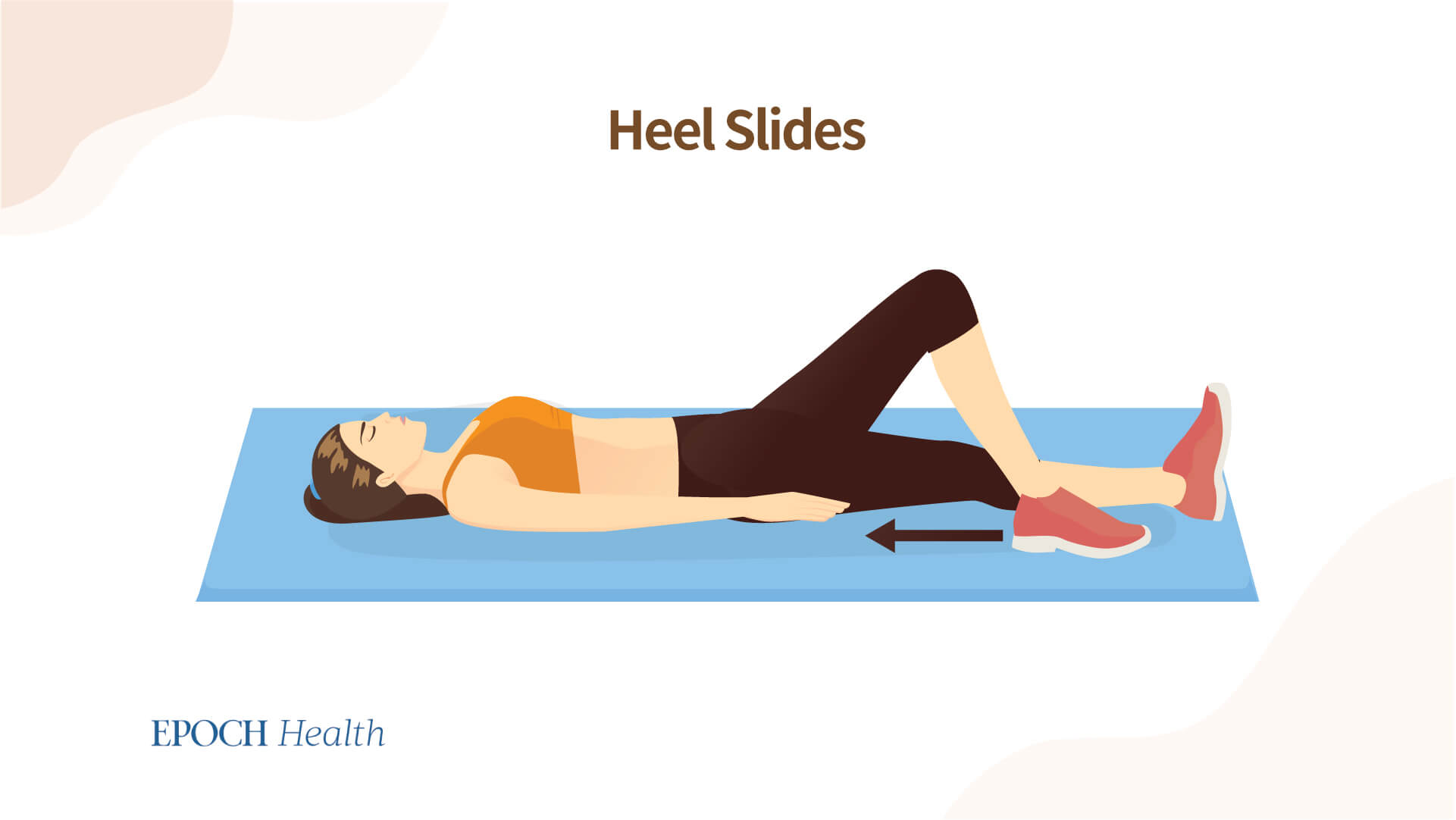
Heel slides engage both the quadriceps muscles and the gluteal muscles, and the purpose of this exercise is to help improve the range of motion.
When doing this exercise, lie on your back, and bend your operated knee by sliding your heel toward your buttocks, while keeping the other leg straight. Then hold for 10 seconds. Your physical therapist may instruct you to pull on a bed sheet hooked around your foot to help you slide your heel. Repeat 10 times as one set, and do two sets a day.
Quadriceps sets
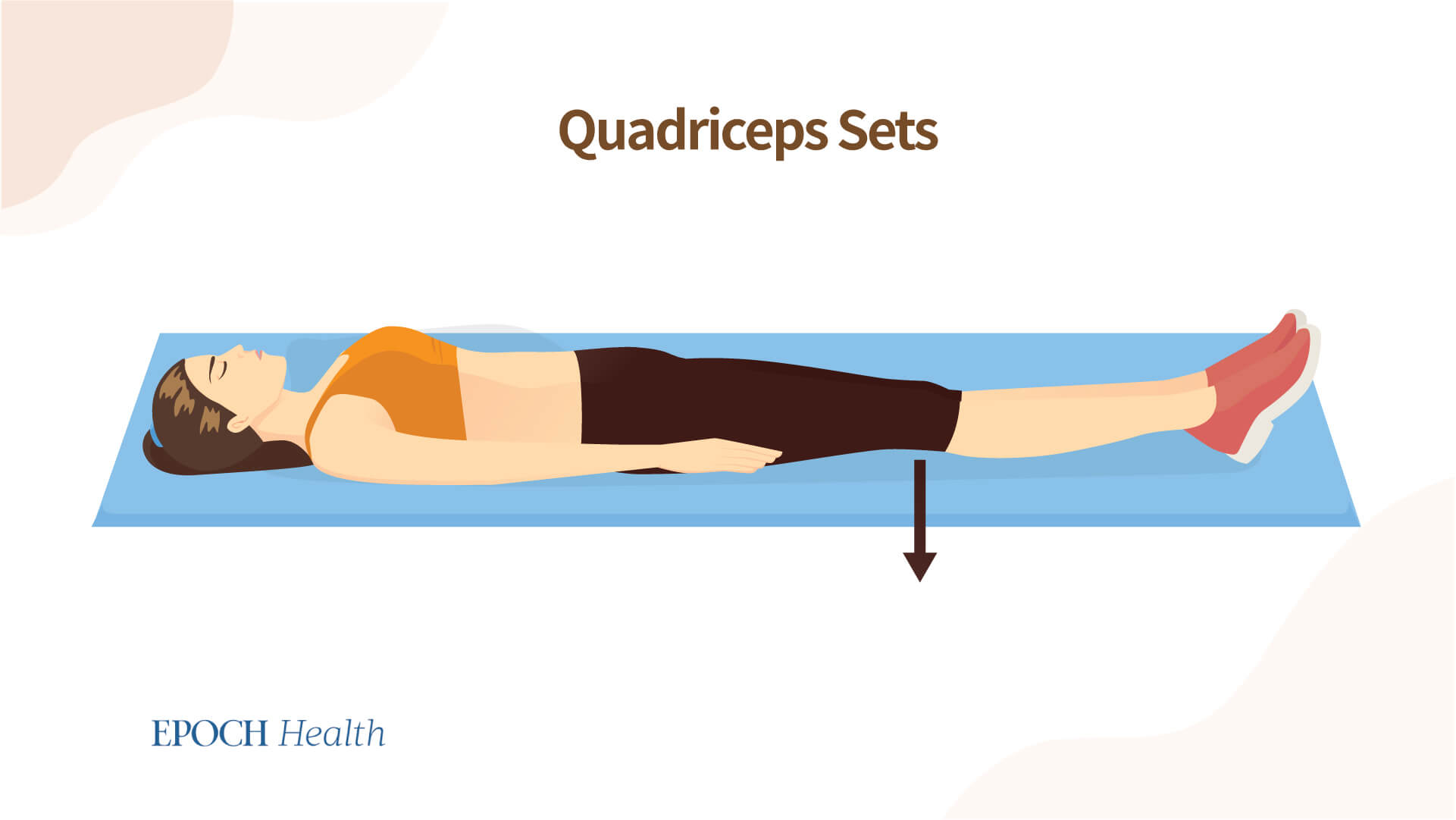
This exercise also improves blood circulation to reduce the risk of blood clots and swelling.
When doing quadriceps sets, lie on your back with your legs straight. Tighten your thigh muscles by pushing your knee down into the bed. Make sure you don’t hold your breath during the exercise. Repeat 10 times as one set, and do two sets a day.
Supported knee bends and straightening with a therapy ball
The goal of this exercise is to eventually enable the recovering knee to bend to a 90-degree angle. A 90-degree knee bend is needed for you to go up the stairs, and a 110-degree knee bend to go down the stairs. However, this exercise is not suitable for people with back pains.
When doing this exercise, lie on your back and rest the heel of your operated leg on a therapy ball, while keeping your knee cap pointing to the ceiling. Roll the ball towards you to bend your operated knee, and roll the ball away to straighten that knee. Repeat 10 times as one set, and do three sets a day.
Passive knee bends
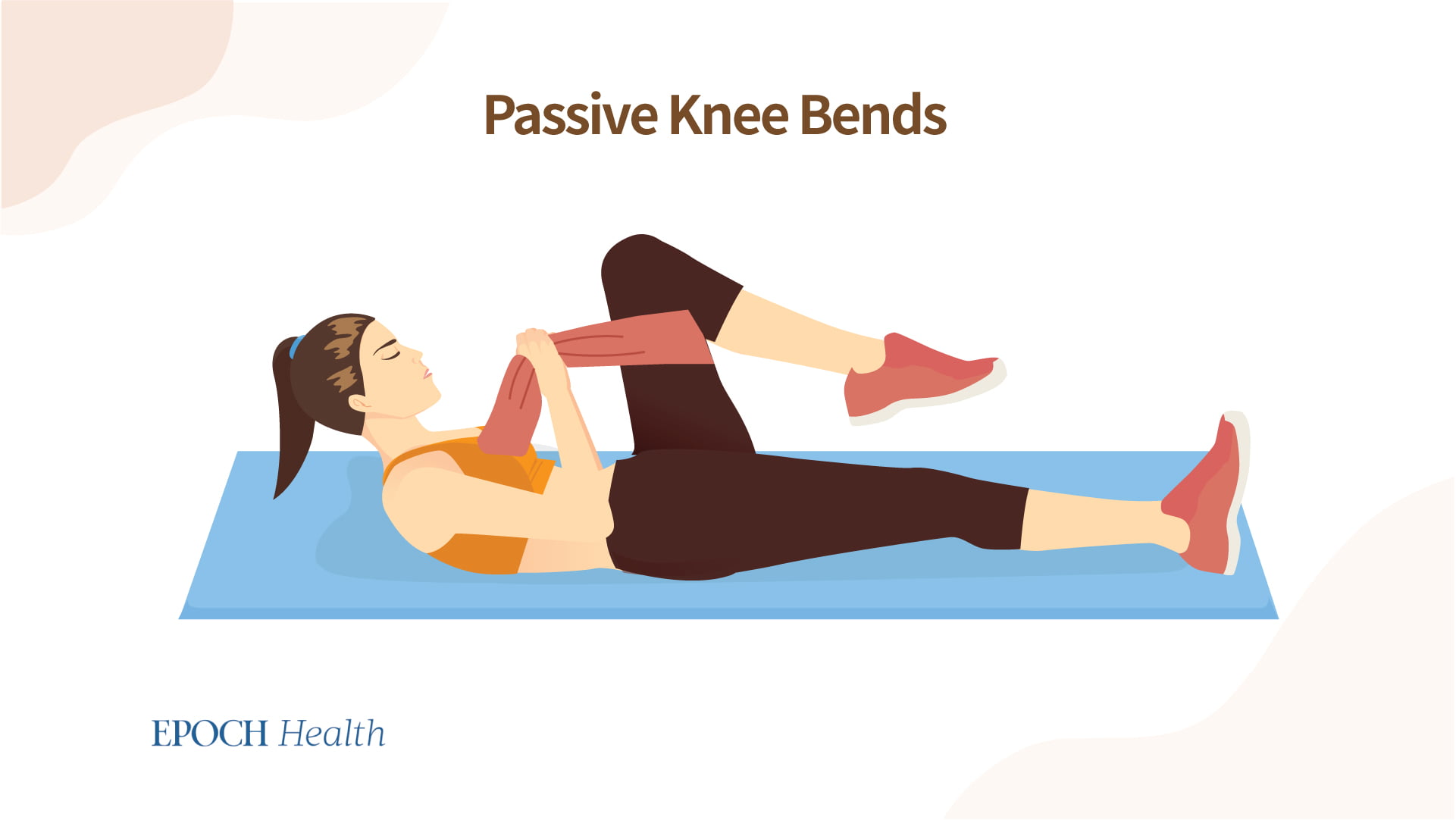
The goal of this exercise is the same as the supported knee bends.
When doing passive knee bends, lie on your back, and put a towel or strap behind your thigh to provide support. Pull your thigh toward your chest with the towel and relax your recovering knee to increase the bend. Hold for five to 10 seconds. Repeat 10 times as one set, and do three sets a day.
Seated knee extension
This exercise is used to straighten your recovering leg.
When doing seated knee extension, sit tall on a firm chair. Keep your thighs fully supported on the chair, and your non-recovering leg supported on the floor. Straighten your recovering leg out, and then lower it. Repeat 10 times as one set, and do two sets a day.
After doing these exercises, apply ice pads for 15 minutes. In fact, you can apply icing several times a day after the surgery to help prevent swelling, stiffness, and pain.
Stage 2: 3 to 6 Weeks after Surgery
At this stage, the patient’s recovering leg continues to regain strength, and the patient might not be relying on a cane or crutches to walk. The goals at this stage are to regain the full motion of the recovering knee and to continue regaining strength. Knee bends should concentrate on the goal of enabling the knee to bend to a 120-degree angle.
The patient should continue all the Stage One exercises, and at this time, he or she should perform all of these exercises on both legs to keep the balance between the recovering and other knee. More low-impact activities can be introduced into the exercise regimen, including swimming. The patient can also do some light housework. If the patient has an office job, which doesn’t require much physical activity, he or she can even go back to work.
Some of the exercises added in this stage include:
Straight leg raises
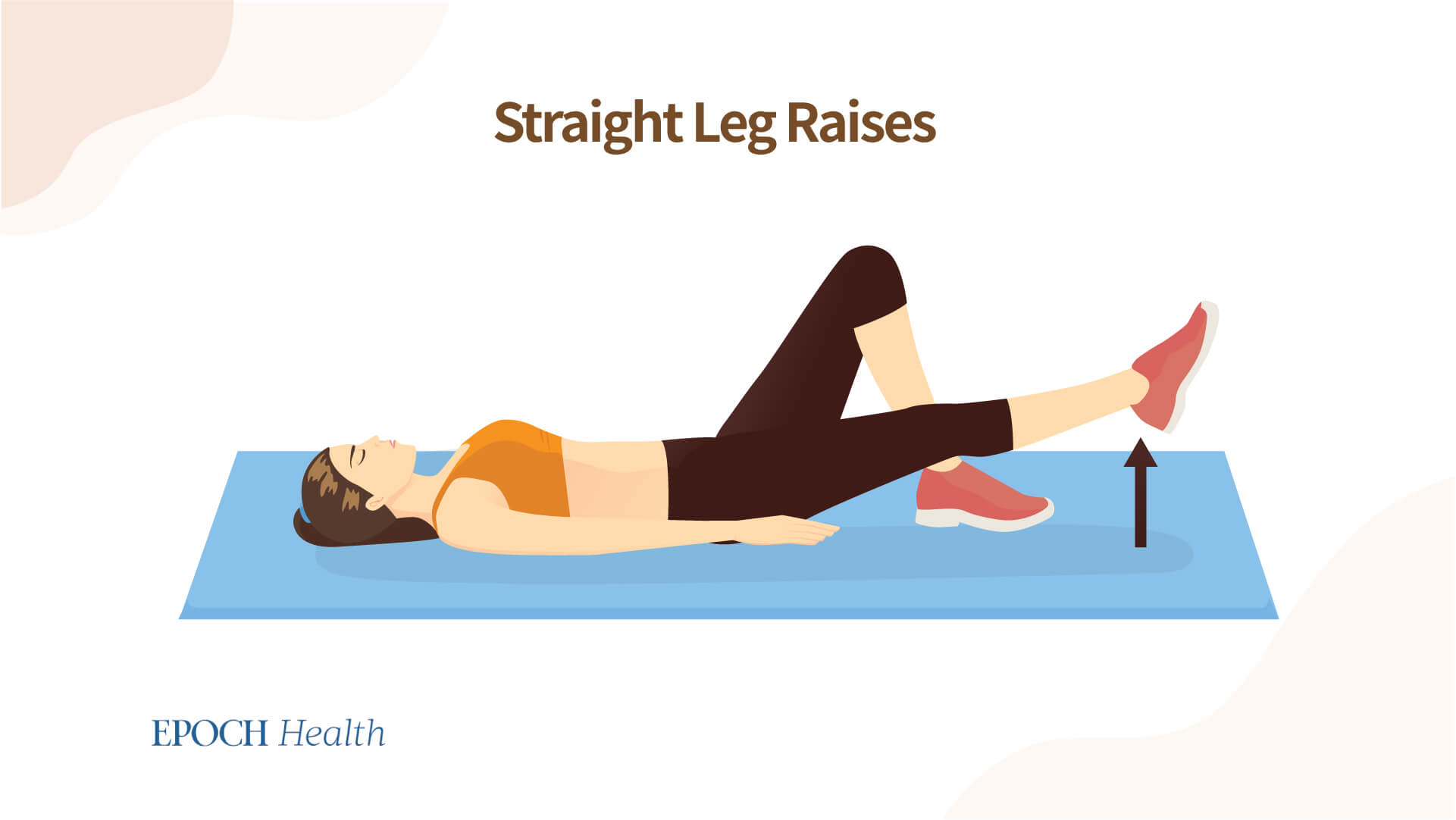
This exercise can strengthen your recovering leg. Since certain muscles were cut during the knee replacement surgery, this exercise can be challenging at first.
When doing straight leg raises, lie on your back and keep your back flat throughout the exercise. Bend your non-operated leg. Tighten your knee on the operated leg and slowly lift your leg to the level of the bent knee. Then gently lower the leg to the bed. Repeat 10 times as one set, and perform two sets per day.
Standing squats (or squats with a chair)
This exercise helps the leg muscles regain their strength.
When doing standing squats, you start with a standing position, while holding onto a chair or bed on the side. You then sit back into a squatting position by bending your knees at 45-degree angles, and then return to the standing position. However, these squats are not deep, as that would be very challenging at this stage. If standing squats are difficult for you to perform, you can also squat onto a steady chair. Repeat 12 to 15 times as 1 set, and perform 4 sets per day.
Active knee bend and straightening

This exercise improves the operated knee’s range of motion by increasing the degree of its bends.
When doing this exercise, lie on your stomach with both of your feet close to the end of the bed. Bend your operated knee to bring your heel towards your buttocks. Then straighten your leg and let your foot hang over the edge of the bed. Hold each position for five to 10 seconds. Repeat 10 times as one set, and perform three sets per day.
Stationary bike riding
This is an excellent exercise to improve the operated knee’s range of motion and mobility while strengthening the leg muscles.
First start with rotating the pedals backwards, if fully riding the bike is challenging for you. Then you can try to pedal it forward. Once your operated knee strengthens to the point that you can truly ride the stationary bicycle, bike for 10 to 15 minutes on low resistance, twice a day. Then you can gradually increase the exercise duration to 30 minutes, four times a week.
Besides the above mentioned exercises, you should also do calf and hamstring stretching to strengthen your leg muscles.
Stage 3: 7 to 12 weeks after surgery
At this stage, the patients should have a wide range of motion in the operated knee and be able to perform many low-impact activities. As they are more confident with their daily activities, many of them will soon get back to work and resume their social life. High-impact activities should still be avoided.
The goals by week 12 include fully straightening the operated knee, walking longer distances without a limp, identifying and addressing any motion deficits, going up and down stairs normally, and improving functional strength. Other goals may include riding a stationary bike or bending the operated knee to 120 degrees, if the patient hasn’t achieved these goals in the previous stages.
Patients should continue with all Stage Two exercises and perform several more, including:
Single leg balancing
The purpose of this exercise is to train your balance to reduce the risk of falling and restore your normal gait.
When doing this exercise, always have a firm railing or stable furniture within reach to avoid falls. In a standing position, lift one leg off the floor, while balancing on the other leg. Then switch legs and repeat the exercise. Hold each position for 30 to 45 seconds. Repeat several times every day.
Front lunges
Front lunges can also help improve your balance and strengthen your thigh and hip muscles.
When doing this exercise, hold a chair or counter for support. First, place the operated leg behind and bend the knee to bring the heel towards your buttocks. Then switch legs and do more lunges. The lunges should be shallow at this stage, until you feel more comfortable to go deeper. Hold for five to 10 seconds. Repeat 10 times as a set, and perform three to four sets a week.
Front/lateral step ups
These exercises can improve your balance and rebuild your functional strength.
When doing front step-ups, you stand facing a step. Step up by lifting one leg first, then bring up the other leg, so you stand on the step. Then step down, switch legs, and repeat. Repeat 10 times as a set, and perform three to four sets a week. Lateral step ups are performed in a similar fashion, only sideways.
Wall squats
This exercise also improves your balance.
When doing wall squats, you lean up against a wall, with your feet about 1 to 1.5 feet from the wall. Bend your knees down to 45 degrees, while sliding down the wall. Keep your tailbone against the wall at all times. Then use your lower buttocks to slide back up the wall. Repeat 10 times as a set, and perform three to four sets a week.
At this stage, you can also walk on a treadmill to rebuild your endurance.
Stage 4: More Than 12 Weeks after Surgery
At this stage, the goal is to return to full activity. Most physical therapists recommend continuing the exercises from the first three stages for up to 12 months for maximum recovery.
Patients can begin regular cardiovascular exercises, by starting with 15-minute sessions. They can also resume functional exercises, such as golfing and playing tennis. However, before resuming any such activities, patients should first consult their physician or physical therapist.
If exercising in a gym, the patients can use a leg press machine and do dumbbell squats.
Once recovered from the surgery, people should also take care of their knees and general health to extend the life of the knee implants and to avoid the need for a second knee replacement surgery.

